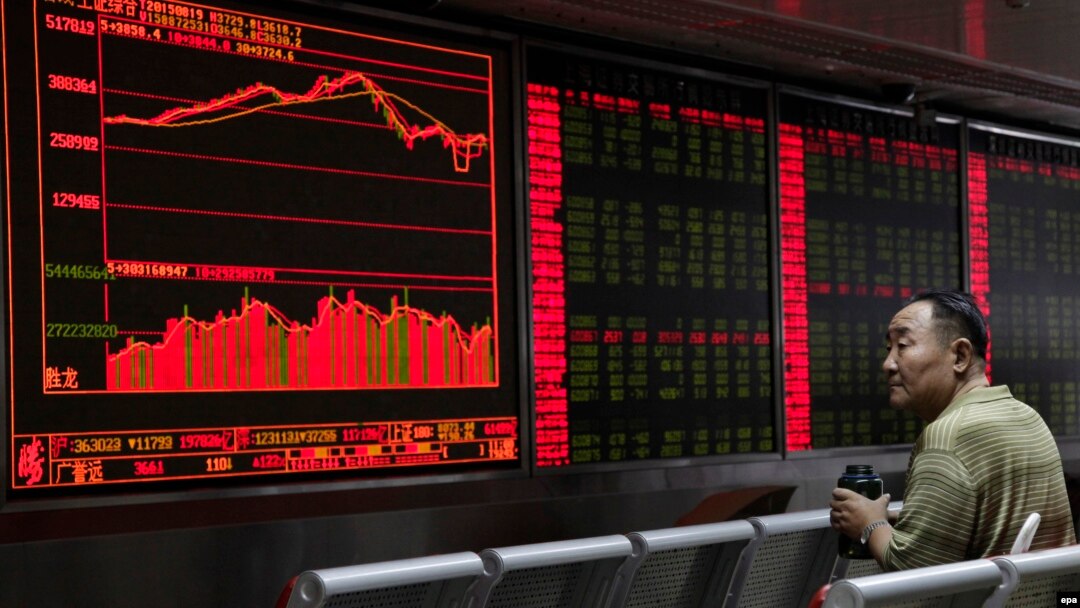A nearly 9 percent dive in China shares sent world stocks and commodity prices plummeting on August 24, with Wall Street suffering its worst day in four years.
Gut-wrenching stock losses between 5 percent and 6 percent in European and Asian stocks sent the Dow Jones Industrial Average into a tailspin in the first four minutes of trading in New York, when it dropped a breaktaking 1,089 points. The Dow and other U.S. indexes later cut their losses after buyers rushed in to take advantage of bargain prices for prized blue-chip stocks.
The wild swings and heavy churning of stocks on Wall Street had not been seen since the 2009 global financial crisis and left the century-old Dow index down 3.6 percent or 588 points at the close of trading.
U.S. stocks were able to weather the global crash somewhat better than other major markets in part because Tim Cook, the chief executive of Apple, issued a statement midday saying the computer giant and world's most valuable company was still confident in the key Chinese market.
The Standard & Poor's 500 index recovered about half its losses to close down 3.9 percent -- still 11 percent lower than its May record high. Major U.S. indexes had plunged 5 percent at the end of last week.
While the bounce in U.S. stock indexes from the day's lows was a hopeful sign, investors were apprehensive about more bad news coming out of China, the world's second-largest economy and a major engine of growth for commodity producing countries from Russia and Kazakhstan to Iran, Iraq, and Brazil.
The free-fall in the stock market was "made in China," said David Kelly, chief global strategist at JP Morgan Funds, having started with China's move to devalue its currency two weeks ago and accelerating at the end of last week after a report showed the worst manufacturing performance in China since the global crisis of 2009.
"If things don't settle down in China we could have another ugly" experience when markets open again on August 25, said Randy Frederick, a managing director at Charles Schwab.
Asian stocks opened sharply down, with Shanghai's battered stock index tumbling another 6.41 percent and Tokyo stocks losing 4.13 percent.
The selloff continued despite a move by Chinese authorities to try to bolster market confidence and prices by authorizing the state pension fund with 3.5 trillion yuan in assets to buy stocks.
The global bloodbath on August 24 took trillions of dollars off the value of stocks worldwide. The stunning drop in Chinese stocks was their worst performance since the depths of the global financial crisis in 2007 and wiped out what was left of a 50 percent gain that the Chinese market had posted earlier this year.
Many traders had hoped Beijing would take support measures, such as an interest rate cut, over the weekend after China's main stock markets slumped 11 percent last week.
The rout in China sent Asian shares plunging 5.9 percent to three-year lows and drove Tokyo's Nikkei index down 4.6 percent.
European stocks followed suit, tumbling another 5.4 percent. London's FTSE 100 dropped by 4.7 percent in a 10th straight decline -- its worst run since 2003. The CAC 40 in Paris plunged 5.35 percent and Frankfurt's DAX 30 index fell 4.70 percent.
The downturn in China's economy has raised worries for Europe's fragile economic recovery, as China has been the fastest growing importer of German cars, French wine, and other lucrative European exports.
China has the world's biggest market for cars and has been the fastest growing market for crude oil. Its woes have been pressuring oil prices and oil producers like Russia, Iran, and Iraq all year.
On August 24, oil broke through the $40 a barrel barrier in New York and plunged to 6 1/2-year lows. U.S. premium crude prices settled down 5.5 percent at $38.24 a barrel after falling as low as $37.75. Brent prices settled off 6 percent at $42.69 after falling as low as $42.51.
China's weakening manufacturing and building sectors sent copper, a barometer of global industrial demand, to a six-year low. Nickel fell sharply.
Investors pulled their money out of stocks and commodities and flocked to safe havens like U.S. and German government bonds.
With serious doubts emerging about the likelihood of a U.S. interest rate rise this year, the dollar was down 1.6 percent against other major currencies after falling as much as 2.5 percent earlier in the day.
By the end of the day on Wall Street, stocks worldwide had lost another 3.8 percent of their value, as measured by the MSCI all world stock index.


